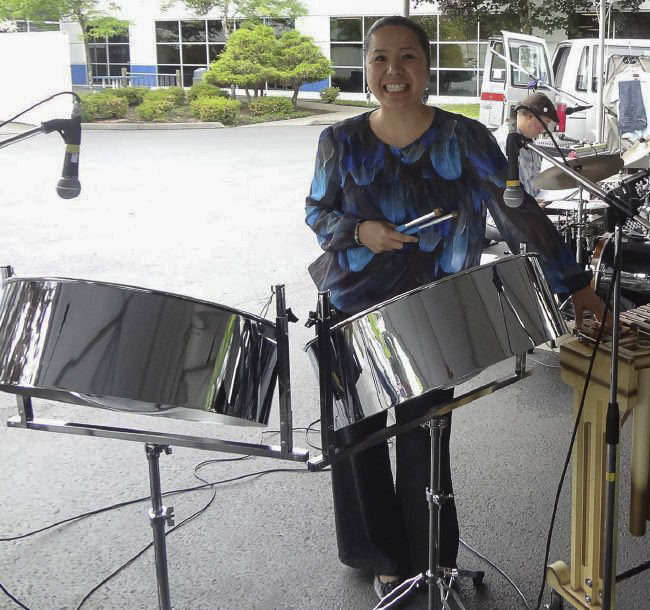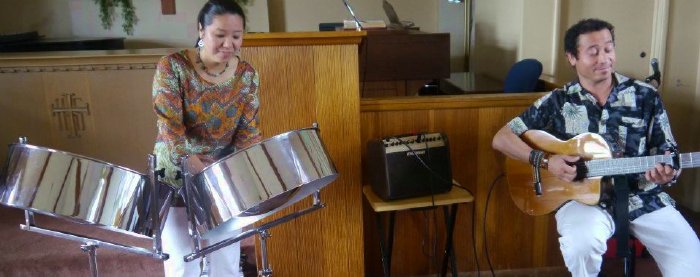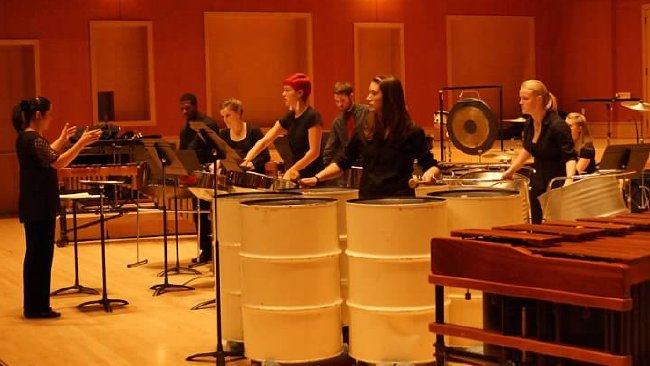
WST - “Tell us about Miho yourself?”
Miho T. - “My name is Dr. Miho Takekawa, born and raised in Tokyo, Japan. Currently, I teach percussion at Pacific Lutheran University (PLU), where I direct the school’s Percussion and Steel Pan Ensembles. During the 2010-2011 school year, I served as the interim professor of Percussion Studies at the University of Washington, School of Music.
“I began piano at age three and took up percussion at thirteen, ultimately graduating from the Kunitachi College of Music with both percussion performance and music education degrees. I pursued my studies at the University of Washington (UW), and earned masters and doctoral degrees.
“I am the co-founder of Miho & Diego Duo; a board of trustees member of an after-school steel pan orchestra, “Steel Magic Northwest”; a member of the Seattle Women’s Steel Pan Project; a founder of the Japan-U.S. Music Exchange Program, “TY Music Exchange”; and a member of the Seattle Modern Orchestra. I am further requested to join various groups in Washington. In addition to the music students at PLU, I have 30 diverse students, 90% of color, who take private percussion, piano, and music theory lessons.”
“東京出身、武川 美保と申します。現在、ワシントン州のパシフィックルテラン大学にて、打楽器講師と、打楽器アンサンブル、そしてスティールパンアンサンブルの指揮をしています。2010〜2011年の間、ワシントン大学の打楽器科の臨時教授を務めました。3歳からピアノを学び、中学校の吹奏楽で打楽器を。国立音楽大学附属高等、そして大学を卒業後、ワシントン大学の大学院にて、打楽器の博士号を修得しました。
“大学で教鞭を取る他、「美保&ディエゴ デュオ」、放課後プログラム「ステールマジックノースウェスト」の副委員長、「シアトル ウーマンズスティール パン プロジェクト」、「シアトル モダン オーケストラ」、日米音楽交流会「TY 音楽交流」委員長を始め、ワシントン州の多くのグループと共演。また、30人の有色人種の若者に、打楽器、ピアノ、そして音楽理論を教えています。”
WST - “When and how did you first become aware of, and involved with, steel pan?”
Miho T. “I was familiar with steel pan instruments before going to the U.S. Starting in 1998 with Ray Holman, visiting professor at the UW, I took private pan lessons and steel band classes for two years.”
“スティールパンの存在は日本にいる時から知っていましたが、演奏した事はありませんでした。1998年に、ワシントン大学にトリニダードから、レイ ホールマン先生がいらした時に、スティールパンレッスンとアンサンブルの授業を取ったのがきっかけです。”

Miho Takekawa
WST - “You wear multiple hats such as musician, arranger, educator, director, percussionist, pianist, performing artist, workshop facilitator and more. How do these roles complement each other, and is there a preference?”
Miho T. - “Everything I do is strongly connected. For me, my job is all about passion, discipline, and dedication to music. There is not a preference. When I join a group as a performer, sometimes I find myself “teaching” other members as well. When I perform, oftentimes I arrange the music in a way that works for the group. When I teach, I learn about the abilities of my students and their potentials.”
“現在、やらせて頂いているもの全てが繋がっていると、強く感じています。どの楽器に関しても、音楽に対して情熱、鍛錬、そして専念する事を基本として取り組んでおり、好きな仕事の順序は、特にありません。グループのメンバーとして参加しても、他のメンバーに教えたりしている自分がいたり、良い曲があれば、自分のグループに合うように編曲をしたり。教えている立場でも、生徒の成長度、言葉の使い方、可能性について学ばせてもらっている自分を見つけます。やらせて頂いている1つ1つが、お互い、補っていると思います。”
WST - “You have studied with one of the true legends in the steel band art form - Ray Holman; talk about that experience?”
Miho T. - “When I heard Ray Holman play on the double-seconds, I could not believe my senses. This was clearly beyond what any words could express. He often chose to give private lessons outside of the music building, so he could be inspired to write a new piece. Ray grabbed his guitar, and my friend Eiko and I carried the double-seconds outside. He asked that Eiko and I teach him Japanese folk songs on the pan. I vividly remember while we were out-of-doors, he looked around on that spring day, and began singing and creating specific melodies with additional complementary chords on the guitar. He asked me to transcribe the melodies he was humming to sheet music, since I have perfect pitch. It was such a musical and artistic moment, when I understood why his compositions resonate so well with many people.
“The way Ray taught steel band was very different from anything I knew as a classically-trained musician. I wanted to improve my feel of the Calypso drum set, so I asked Ray if he would teach me. He instructed me to play the hi-hat pattern the entire quarter! He insisted that I should have a better “feel,” when I opened the hi-hat. I struggled immensely, but looking back now, I truly appreciate the lessons. I also thanked Dr. Shannon Dudley, a UW Ethnomusicology Professor, who brought Ray Holman as a Visiting Professor.”
“レイ ホールマン先生のダブルセカンドパンから奏でる音を聞いた時、その美しさに、言葉が出ないほど感動しました。ホールマン先生は、屋外で新しい曲のためのインスピレーションを受けるため、よくレッスンを屋外で行いました。先生がギターを持ち、その時一緒にレッスンを受けていたEikoさんと私は、スティールパンを屋外に持ち出し、日本人である私達が、先生に日本の童謡を教えた事もありました。ある春の日、屋外レッスンで、先生がメロディーをハミングし、ギターで伴奏付けをし、そのメロディーを私が楽譜に書き下ろした事も、鮮明に覚えています。それはとても音楽的にも芸術的な瞬間で、たくさんの人達がホールマン先生の作曲を好むのが理解できます。
“クラシック畑出身の私にとって、ホールマン先生のスティールバンドの教え方は、驚きに満ち溢れていました。私は、スティールパンの他にも、カリプソリズムのドラムセットをもっと上手になりたかったので、先生に教えてもらえないか、と相談しました。ホールマン先生は、ドラムセット全体よりも、カリプソリズムは、ハイハットを開けるタイミングが一番大切!と言って、1学期中ずっと、私はハイハットだけを練習。その土地に伝わるリズムが持つ「フィーリング」というのを学ぶのはとても難しく、苦労しましたが、今では大変ありがたい経験となっています。また、ホールマン先生を、ワシントン大学に招待した民族音楽学教授Shannon Dudley 博士に感謝をします。”
WST - “You play other instruments in addition to pan, including the marimba. Talk about the contrasts and similarities?”
Miho T. - “The basic theory is the same when I play any percussion instrument, including the piano. If one wishes to improve his/her performance, practice is the key. However, I would point out that the process of learning various “musical styles” is different. I have learned how to shift my brain when I play the classical “Cello Suites” by J.S. Bach on the marimba to playing the Afro-Colombian “Caderona,” on the same instrument. Those two completely different styles of music can be played on a regular marimba, but mentally I must visualize different images/stories in my mind. This can be applied to pan music as well. When I direct the PLU Steel Pan Ensemble at a church, we play Christian hymns. I take the classical music approach for those hymns, but the next piece we perform could be a Calypso tune. I tell my students to feel the rhythms for Calypso music, where I encourage them to move their bodies with the music, if they choose. Intensive research into the specific “musical styles” is one of the most important aspects of understanding how to interpret the selected piece of music. For me it is also absolutely vital to know how to play a certain instrument. Learning the specific musical style requires significant research until it becomes a part of my system. It is akin to learning a new language.”
“何の楽器を演奏するにも、基礎は同じだと思います。上手になるためには、練習が必要。ただ、「音楽のスタイル」を勉強するプロセスには違いがあると思います。バッハの「無伴奏チェロ組曲」とアフロ・コロンビアの「カデロナ」を演奏するには、同じマリンバで弾いていても、頭の中では完全に違うイメージを持たなければならず、勉強した、各「スタイル」を演奏の中に取り入れます。これは、スティールパンにも応用されますね。私が大学のスティールパンアンサンブルを、教会での演奏会に連れて行く時は、よくキリスト教ミサ曲を取り上げます。この際には、クラシック音楽のアプローチですが、次に演奏する曲が、カリプソのリズムの曲の場合があります。私は、生徒達にカリプソの曲を演奏する際には、ビートを体で感じ、もし、体や足が自然に動くのであれば、それをわざと抑えなくて良い、と教えます。ですので、「音楽のスタイル」を研究する事は、コンサートのレパートリーを選択する上でも、大変に重要なものです。私にとって、ある一定の 「音楽のスタイル」が体に一部となるまで研究し続ける事は、楽器の演奏法を学ぶのと同じ意味を示します。楽器は同じでも、違う「音楽のスタイル」を勉強する事は、新しい言語を学ぶのに似ていると思います。”

Miho Takekawa (left)
WST - “Share on some of your overall experiences as a performing artist in general (not limited to pan), and also as one-half of the “Miho & Diego Duo” with your husband?”
Miho T. - “Life as a musical performer has been a journey of hard work, yet I feel extremely fortunate that Miho & Diego Duo is a significant part of my life. Diego and I have performed in Japan multiples times, Chile, Bolivia, California, Oregon, and Washington. Since the Duo is simply Miho and Diego, we won’t replace either with anyone else. This is a commitment we made, and I am glad that we did. Proudly I present Japanese folk songs arranged for bamboo flutes (quena and zampoña) and marimba. Diego teaches me about four different regions of Colombian music, and I arrange them for the marimba. Through countless numbers of performances, from small coffee shops to 1800-seat concert halls, I have learned to perform with the same preparation and rigor each time. Oftentimes we have applied and been awarded grants to perform in low-income schools. My heart sadly aches when I realize a number of the students may not have dinner that night. When we play at Japanese nursing homes, the residents’ eyes fill with tears as they listen to the Japanese music we perform. I love playing my favorite Harry Belafonte and Caribbean songs, which cause the residents to move with the rhythm, then share with me their first loves when the music was popular. Although there have been some bumps in our road during the past years, such as negative comments on the combination of bamboo flutes and the marimba, and discrimination due to the fact that we are both immigrants, I’ve been telling myself to stay strong, focus on the music, keep learning, and aim higher. To perform as Miho & Diego Duo is an emotional journey, because each song I play is of significant importance to me and the listeners.”
“演奏家として活動するのは、大変な事ですが、Miho & Diego Duoの結成は、現在、素晴らしい事をもたらしてくれています。日本で何度も演奏させて頂いている他、チリ、ボリビア、カリフォリニア、オレゴン、そして住んでいるワシンントン州の各地で演奏をしています。私達2人の名前をグループ名にわざといれ、トラを立てられない形にし、自分達が責任をもつようMiho & Diego Duo となっています。これは、本当に良い決断でした。日本の曲を、アンデスの笛(ケーナ・サンポーニャ)とマリンバにアレンジしたり、ディエゴは、故郷コロンビアの4つの違う地域に伝わる音楽を私に教え、それをマリンバに合うように、アレンジしたりします。今まで、数え切れないほどの演奏を、小さなカフェから、1800人収容のコンサートホール等の様々な所で演奏してきました。その経験から、どこでも同じ準備をし、同じ気持ちを込めて演奏する事の重要さを学びました
“市や郡からの音楽助成金制度に応募し、授与した際は、低収入学区域で演奏をする活動もしていますが、自分達ではコントロール出来ない貧困層の立場にいる子供達へ演奏した後、その夜、その子達の何人に一人かが、夕食も食べれない状況にいる、というアメリカの現実に、心が痛みます。日系やアジア系のシニアセンターで演奏すると、日本の曲に涙を流してくれる方々。自分の音楽が、人の心を打つ事を事実を見れる事もあります。アメリカ人中心のシニアセンターでの演奏会では、私の大好きなハリー ベラフォンテやカリブの曲を演奏すると、皆の体が自然に動き、コンサート後にはシニアの方々が、演奏した曲が流行した頃に、若かった彼らが経験した初恋の話しをシェアしてくれたり。ここまで来るにはかなりの沢山の山を越えてこなければなりませんでしたし、「マリンバとアンデスの笛のコンビは合わない」、「移民の私達がアメリカ人に与えられるはずの仕事を盗んでいる」等、色々な事を言われてきました。しかし、私はまず気持ちをしっかり持ち、音楽に集中し、学び続け、向上を目指す事を自分に言い聞かせ、辛い時期を通ってきました。Miho & Diego Duo の演奏活動は、私にとってもそして、聞いてくださる方々にとっても感情的な音楽の旅といえるかもしれません。”
WST - “Touch on your interaction as the director for the Pacific Lutheran University steel pan ensemble?”
Miho T. - “Initially, the PLU Steel Pan Ensemble was started by Dr. Greg Youtz, who is a composition professor as well as a music historian of early Trinidadian music and Chinese music/culture. He established a sister-University affiliation between PLU and the University of West Indies in Trinidad. I have four different categories of pan music that I carefully choose for a final performance at the end of every semester: 1) Trinidadian folk song, 2) classic, 3) Jazz (or Latin Jazz), and 4) either hymn, American popular song, or Panorama piece. It has been a positive ensemble teaching experience because I don’t require students to be able to read music to join the group. I ask students who have spent an entire semester in Trinidad to share their stories and photos with the other members of the group. It is a performing ensemble class; however, I truly want my students to learn how the instruments have been developed, how large pan music has expanded in the world, and how the history unfolded. I show Panorama videos to introduce what/how people play pans in Trinidad. I make clear that the PLU Steel Pan Ensemble has its own identity. My objective is not to duplicate Trinidadians at the Panorama. I want my students to think critically about the best way to represent and interpret the Steel Pan Ensemble music at PLU.”
“私が大学で教え始める前に、同大学の作曲家の教授でもあり、トリニダードの音楽歴史と中国の音楽と文化の研究者でもあるGreg Youtz博士が、PLU スティールパンアンサンブルを結成されました。彼は、我が大学と、トリニダードのWest Indies大学と姉妹校の発起者でもあります。私は、毎学期の最後に行われるアンサンブルクラス学期末コンサートに、4つにカテゴリーからレパートリーを注意深く選択します。1)トリニダード伝統曲、2)クラシック、3)ジャズ(またはラテンジャズ)、4)ミサ曲、アメリカのポップ音楽、またはパノラマコンクールから1曲。私にとって、教えるのに大変意味のあるものになっている理由の1つは、生徒が楽譜を読む事を必修としていない事もあげられると思います。また、姉妹校の一環として、トリニダードで1学期を過ごした生徒には、写真や経験談を他の生徒の前でシェアしてもらったりもします。これは、アンサンブルの授業ですが、私は生徒達に楽器の発展や、世界中に広がっていくスティールパン文化、そしてその歴史を知る事を、授業の一環としています。パノラマコンクールのビデオをよく見せ、トリニダードではどのようにスティールパンが演奏されているかを説明しますが、そこで必ず口を酸っぱくして言う事は、PLU スティールパンアンサンブルは独自の個性を持っていて、必ずしもトリニダードの演奏の仕方を真似するために存在していない、という事です。これから羽ばたいていく生徒達には、自分達が演奏する音楽は、自分達の力で注意深く解釈していく力を備える事が大切だと教えていきたいのです”
WST - “You recently started playing with ‘The Seattle Women’s Steel Pan Project’ - what led you to the band, and share your thoughts and experiences with the group?”
Miho T. - “It’s been amazing to witness how these women have grown musically as performers, improving steel pan playing, and bonding with each other though steel pans. I have known Michael Shantz, the Artistic Director, over many years. His leadership, personal connection with each member, and vision for women especially those of color and their communities to succeed, have been magnificent. A co-founder, Oriana Estrada, is a professional woman and accomplished dancer, who brings so much gentleness and trust to the members, as well as the audience. She practices the steel pan more than anyone else, so she has been a great role model to the group. What is exciting about this group is that all the members have completely different backgrounds (ethnicity and music) but they listen to each other very well. I am relatively a new member, but I feel that we all connect like sisters. The Seattle’s Martin Luther King Jr. Community Center became a safe and comfortable place for the group; as we all know we have our personal good and not-so-good days at work and life in general. Some are mothers who could have sick kids on a rehearsal day. This group cares for each other and communicates well amongst themselves; just think what they can do to help someone in great need. Through these events when the group plays, it is clearly apparent that the cohesiveness of the group shines through their music. As I know how difficult it is to sustain a musical group, I want to help and contribute as much as possible.”
“彼女達が演奏家として、音楽的にも、そしてテクニックも上達し、そして
“スティールパンを通して、強い絆を深めていくのを見るのは、素晴らしい事です。アーティスティック ディレクターのMichael Shantzは昔からの友達で、彼の持つリーダー性、メンバーへの心のケア、そして有色人種の女性達とそのコミュニティーへの理解と先見の明は飛び抜けていると思います。発起者、Oriana Estradaは、キャリアウーマンでプロのダンサー。彼女は、メンバーにも、そして観客にも隅々まで気を遣い、信頼を得ています。人種も、音楽的にも全く異なる女性がメンバーとなっているこのグループの1番良いところは、お互いに聞き合う耳を持っている、という事でしょう。リハーサルを行うシアトルの、マーティンルーサーキングJrコミュニティーセンターは、このグループの女性達にとって、精神的に、また、 仕事上や生活の中でのアップダウンがある日々の中でも、安全で心地良い場所となっています。メンバーには母親業をしながらリハーサルに来る人もいて、子供の病気やその他で大変な時には、メンバーお互いが助け合っています。このような事を通して、メンバーの気持ちが合ってくるので、アンサンブルの時には、音楽的にもリズムが合ってきているのを感じます。学校以外で、大きなグループを保持するのを難しいのを知っているので、私のできる限りグループのために助けていきたいと思っています”
WST - “You have worked with steel bands in your home country of Japan, such as the North Rainbow Steel Drum Group and the Hirosaki University Steel Pan Group; talk about your involvement there?”
Miho T. - “While I was living in Sapporo, Hokkaido between 2005 and 2006, some folks who play steel pan contacted me. They were enthusiastic Japanese pan players who practiced by themselves but didn’t know how to start a group. I didn’t have my double-seconds in Japan, so I decided to step in as a group coordinator, instructor and arranger. I had a great time learning what they like to play as far as repertoire goes because I never played pans in Japan before. I remember that I played Ray’s CD for them many times. Before I left to go back to the U.S., we had a very successful concert with a Sapporo local Latin band.
“My friend, Akira Tomita who is an art professor at Hirosaki University invited me to visit his school’s steel pan club. Akira has published a few books/articles about Trinidad, pans, and its culture in the Japanese language. I brought my own arrangement of “Poun Poun” that was verbally told by Ray Holman.
“For me it was a memorable experience both in Sapporo and Hirosaki University because I was able to share my musical experience that I learned from Ray Holman.”
“2005年から2006年にかけて、北海道の札幌に住んでいた事があります。その際、北海道でスティールパンを演奏する人たちから連絡がありました。彼らは、個人的にパンの練習をしていましたが、グループとしては活動がなかったようなので、自分のダブルセカンドパンを日本へは持っていってなかった私が「ノースレインボー」という名前でグループを結成した彼らのインストラクター、そして、アレンジャーをかって出ました。日本でスティールパンを演奏した事がなかったので、日本人がどのような曲が好きなのか、など参考になる経験でした。レイ ホールマン先生のCDをいつもかけて、メンバーに聞かせていた事を覚えています。アメリカに戻る前に、札幌のラテンバンドとジョイントコンサートをし、とても楽しい思い出となっています。
“同時に、友人であり、弘前大学美術教育学教授、冨田 晃さんから、彼の大学のスティールパン クラブへのご招待を受けました。彼は、トリニダード、スティールパン、そしてその文化についての本を日本語で著書されています。私は、レイ ホールマン先生から口伝達で習った、「Poun Poun」という曲をアレンジしたものを持っていきました。弘前大学、そして札幌「ノースレインボー」の経験は、レイ ホールマン先生の音楽を紹介する機会になったとともに、先生から学んだ事をシェアできた良い思い出です。”
WST - “Do you sometimes meet up with people who are unaware of Pan? If so, how do you describe it to them, as an instrument?”
Miho T. - “I usually try to see if people are truly interested in knowing more about the Pan. For those that are interested, I start from the origin of the country, just to make certain they know that pans are not originally from Jamaica nor Hawaii. Then, I’ll explain that a pan is very similar to the piano; it just doesn’t look like one. Usually that is the time when people look at me and say, “Wait, but you are not Caribbean or …?” I tend to confuse people a lot in the U.S.; therefore, sometimes before explaining about pans, I boldly state, “I was born and raised in Tokyo, Japan, I live in the U.S., and now play and teach steel pans!” Two funny comments I’d like to share: 1) “Do you play with the Stomp?” and 2) “I think I saw you on Waikiki Beach, right?” Apparently, there’s a woman with black hair, who plays pan in Waikiki.”
“まず、その人達がスティールパンを知る事に興味があるかどうか?と確認します。もし、興味を示したら、まずは楽器がどこの国から来たかを話します。ジャマイカやハワイだと思う人が多いですからね。そして、ピアノと形だけが違うだけで、詳細は同じだと説明します。その説明をしていると、(アメリカでの話しですが、)「君は。。。カリブ海から来たんじゃない。。。。よね?」とよく言われます。ですので、スティールパンの説明をする前に、「私は生まれも育ちも日本で、現在アメリカ在住。スティールパンを演奏し、教えています。」と初めに言ってしまう事も少なくありません。2つ面白い事を言われた事があります。1)ストンプ(本来楽器でないものでパフォーマンスをするグループ)と一緒に演奏したりする? 2)確か、ワイキキビーチでスティールパンを弾いてる君をみたよ!(本当に、ワイキキビーチに黒髪でアジア系のパンを演奏する女性がいるとの事”

Miho Takekawa working with group
WST - “Describe your most memorable steel pan musical experience?”
Miho T. - “When Ray Holman and the UW Steel Band were playing a run-through before a concert, he suddenly stopped the band and wanted to change some parts. It was a jaw-dropping moment for me since I was classically trained; what was on the page and played correctly were the proper approach for performing. Ray just didn’t like that particular part... it was very frustrating for me to learn a new part right before the concert. After the change, the harmonies sounded magical.”
“レイ ホールマン先生がワシントン大学のスティールバンドコンサートの、ゲネプロをしている時、突然ハーモニーが気に入らないからなおしたい、と、バンドを止めました。私は、その頃、ページに書かれた事を確実に演奏する、というクラシックのアンサンブルのリハーサルしか知らなかったので、コンサートの前に丸っきり異なる事を覚えなければならない、というのはショックでした。しかし、変更後のサウンドはとても素晴らしく、驚いたのを明確に覚えています。”
WST - “What has been your most disappointing experience regarding steel pan, if any?”
Miho T. - “Personally, I deal with the stereotypical issue of being an immigrant in the U.S. So when people immediately think pans are from Jamaica or Hawaii, it really does not upset me at all. Rather, I think that is a good thing, because at least they are trying to associate pans with some cultures and countries. When people see a steel band formed by Jamaican musicians on Caribbean cruise ships and hear Reggae music played by them, it could be their first time seeing the steel pans. It is natural that people immediately associate pans and Jamaica. As many panists get annoyed by this fact, I secretly thank the Caribbean cruise ship experiences, since those may be their introduction to the pan. They just have to Google it for the actual origin of the pan.”
“アメリカに住む移民として、様々な経験をしてきたので少々の事ではめげませんから、スティールパンはジャマイカやハワイの楽器と間違われる事が多くても、さほど気にはなりません。反対に、どの文化や国から来たのかスティールパンに興味を持ってくれる事は良い事だと思います。カリブ海クルーズ船にのって、ジャマイカ人がスティールパンでレゲエの有名な曲を弾いているのを見た人は、スティールパンがジャマイカの楽器だと思ってしまうのも無理がないですね。しかし、多くのスティールパン奏者が、それの事実を嫌がる傾向にある中、私は実はカリブ海クルーズ船のジャマイカ人スティールバンドに密かに感謝をしています。なぜなら、スティールパンを知る事になる、第一歩になってくれているのですから。その先はネットで調べて事実を知ってくれる事を願うだけです”
WST - “Have you ever participated in Panorama in Trinidad and Tobago, and even if not, what are your thoughts on the event?”
Miho T. - “No, I haven’t. I frequently view the YouTube Panorama videos. Also, I show them to my students in the Pan Ensemble Class. The people of Trinidad and Tobago are proud of the Panorama cultural and musical event. Music competitions don’t really appeal to me, but I do enjoy listening to the music in the Panorama competition. Someday I’ll get there!”
“いいえ、パノラマには参加した事がありません。ネット上のビデオをよく見たり、教えている授業で使ったりします。トリニダード人の国、そして文化のプライドとして存在するパノラマですが、私個人は、音楽コンクールや賞というのをあまり好まないタイプ。でも、パノラマの音楽は大好きです。いつか、参加したいと思っています。”
WST - “If you had the power to change something in Pan immediately, what would that be?”
Miho T. - “Every school (K-12) and college would have access to a Steel Band. Every music education degree in the U.S. would require steel pan techniques and steel directing methods.”
“小学校から高校まで、各学校にスティールバンドを設置。アメリカ大学の音楽教育学科全てに、スティールパン演奏法と、スティールバンドのリハーサルメソッドの授業を必修にする。”
WST - “Are there any other steel band-related matters you would like to touch on?”
Miho T. - “I would like to mention that I am very fortunate to have talented panist/researcher friends in Seattle. Let me start with Michale Shantz, Dr. Shannon Dudley, Dr. Greg Youtz, whom I mentioned above, Gary Gibson and Obe Quarless (professional panists), Jim Morford and Michael DiRoberts (who started and continue the steel band program in the Puyallup School District), Michael Bento (a legendary former elementary steel band teacher), Ian Dobson (a local steel pan group leader), our skilled pan tuner, Glenn Rowsey (who comes to Seattle from West Virginia to tune our pans), my current and former students of the PLU Steel Pan Ensemble, and the members of The Seattle Women’s Steel Pan Project. Each has been extremely important to me as a panist and educator. Steel Band and pan culture have special powers to connect people both in the community and academic levels. I truly appreciate the pan friendship!”
“私は、シアトル近辺のスティールパン奏者や研究者に囲まれ、とても幸運だと感じています。上記でも名前を挙げましたがMichale Shantz, Shannon Dudley博士, Greg Youtz博士、プロのスティールパン奏者Gary Gibson、Obe Quarless、Puyallup 学区域で小学校から高校生対象のスティールバンドを結成し、継続しているJim Morford、Michael DiRoberts、小学校のスティールバンドを州レベルまで発展させたMichael Bento、ローカルスティールバンドのリーダー Ian Dobson, ウエストバージニアから、シアトルにスティールパンのチューニングに来てくれるGlenn Rowsey、私の大学の今までの生徒達、そしてThe Seattle Women’s Steel Pan Projectの各メンバー達。現在、私がこのような仕事をさせてもらえる立場にいるのは、これら皆のお陰である事は間違いなく、有難い気持ちでいっぱいです。スティールパンは、地域活動から、大学まで幅広く人を繋げる素敵なパワーがあります。そこで知り合えたスティールパン友情に感謝!”
photos provided by M. Takekawa
Their Story, Their Voice, Their Life, Their Dreams - click for more stories
Leave a comment in the WST forum






